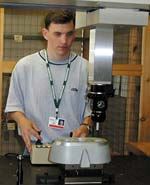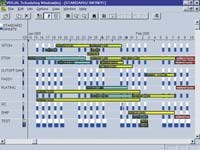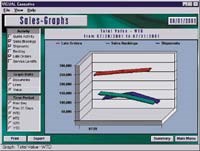Software Cuts Nonconformance Disposition From Weeks To Minutes
The difficulty of accessing quality-related information and the resources dedicated to handling paper led this aerospace machining shop's management to search for an automated solution.
Share










Hwacheon Machinery America, Inc.
Featured Content
View MoreUniversal Propulsion Co. (UPCO) Inc., is a subsidiary of BFGoodrich Aerospace. Located in Fairfield, California, UPCO is a leader in the design, development and manufacture of high reliability, propellant-actuated devices for aerospace and military applications. Quality control and the associated document handling requirements are critical issues for the company. “Since we build explosive devices, we can’t test every item,” says Rick Todd, vice president of quality at UPCO. “Customers must trust the quality of our operations. Because of that, documentation of what we build is critical, and so is the accuracy of that documentation. The ability to control all the different quality-related documents is one of the most important challenges we face.” These documents include CAD models, drawings and change notices; supplier requirements and certifications; purchase orders; manufacturing documents such as work processes, test procedures, equipment calibration and maintenance records; and nonconformance reports and disposition forms.
In the past, UPCO managed these documents manually. Paper forms were physically transported to people who needed them and then filed when they were no longer needed. There were several drawbacks to this approach. First, it took longer to locate archived information. Customers often need to see documents related to product certification activities, revision level status, nonconformance disposition, configuration control and so on. “We would have to dig through files to try and find this information,” says Mr. Todd. “It took longer than we wanted, and since these things were filed manually, there was a chance that they could be misplaced.” The second limitation to this approach was the amount of resources the company devoted to handling paper. Numerous positions throughout the company were dedicated to copying, distributing and filing documents.
The difficulty of accessing quality-related information and the resources dedicated to handling paper led UPCO management to search for an automated solution. The company had recently replaced its aging, mainframe-based inventory control and order entry software with an Enterprise Resource Planning (ERP) system, VISUAL Manufacturing from Lilly Software Associates, Inc. (Hampton, New Hampshire). When UPCO learned that Lilly also offered a quality management system—VISUAL Quality—it evaluated the program as a solution to its document management problems. The system includes 16 modules for managing everything from engineering documents to equipment and tooling records, to skills and training qualifications and outside services. Lilly’s modular approach fit nicely into UPCO’s plan, and another attractive feature was the fact that the quality modules could share information with the manufacturing applications.
UPCO initially considered three VISUAL Quality modules for implementation—Calibration, Document Management and Nonconformance Management. Calibration was the first area that UPCO automated. The company tracks nearly 5,700 gages and other devices, keeping records regarding purchase and installation history, last calibration and when the next calibration is due. The calibration module replaced an in-house DOS program that did not have good reporting capabilities. In addition, calibration laboratory technicians did not trust the accuracy of the previous program’s data, so they kept duplicate information on cards. Now, the accuracy of the calibration module has convinced the technicians to throw the cards away. The software keeps records about all calibrated devices, including supplier certifications that the technicians scanned in and linked to the appropriate device records. “Not only is it impossible for devices to fall through the cracks, the new approach has eliminated a lot of document handling,” says Dick Evans, director of information technology. “We were planning to hire one more person in the calibration lab to keep up with our growth, but that is no longer necessary.”
The next area that UPCO automated was Document Management. The engineering and document control departments use the software to maintain 5,000 of the company’s CAD drawings as well as almost 21,700 manufacturing and test procedures. An interface to VISUAL Manufacturing makes document and drawing numbers available to manufacturing applications. For example, if someone on the shop floor is using a manufacturing application to access work instructions and needs to see the latest revision of a drawing, he or she can determine the correct drawing revision without leaving the manufacturing application. The quality application transmits that information in real-time. Since the document management system was installed, one person in document control who previously did copying and filing has been reassigned.
The third module to be implemented was Non-Conforming Management (NCM). Previously, the report went through the mail to the appropriate engineer who specified the disposition in handwriting on the form. The form traveled back to the quality inspector who carried out the disposition. When that was done, the six-part form was disseminated to the affected departments, which had to maintain these forms in their archives. With the Nonconformance Management module, all this now happens electronically. Reports are generated in the nonconformance application. The software’s use of pre-established values for specific data fields has improved the uniformity of nonconformance reporting, according to Evans. “People select a value from a controlled list, such as ‘production,’ so we no longer have one person entering ‘prod,’ another writing ‘production,’ another writing ‘manufacturing,’ or ‘Building 7,’ and so on,” Mr. Evans explains.
These Non-Conformance reports, now digital, are stored on the server and available to those who need them from their PCs. Access is immediate. This alone has reduced the cycle time for handling NCMs from weeks to minutes. “We now process NCMs more efficiently, allowing us to take the appropriate corrective action,” says Mr. Todd. “The improvements in reaction time and cycle time have been phenomenal.” In addition, two people previously dedicated to filing NCM forms have been reassigned to other work.
UPCO’s customers appreciate the new quality system because it allows the company to respond faster to their questions and requests for documents. For UPCO, the overriding benefit of the new system is similar. It has made information more accessible and more accurate, to the benefit of all quality-related processes. “The new system gives people a single source for data, which has really improved the information flow within our company,” says Mr. Todd. “That, in turn, makes many processes more efficient. Because the accuracy of our documentation is so critical, anything we can do to improve it is extremely important.”
Related Content
How to Mitigate Chatter to Boost Machining Rates
There are usually better solutions to chatter than just reducing the feed rate. Through vibration analysis, the chatter problem can be solved, enabling much higher metal removal rates, better quality and longer tool life.
Read MoreOrthopedic Event Discusses Manufacturing Strategies
At the seminar, representatives from multiple companies discussed strategies for making orthopedic devices accurately and efficiently.
Read MoreCan AI Replace Programmers? Writers Face a Similar Question
The answer is the same in both cases. Artificial intelligence performs sophisticated tasks, but falls short of delivering on the fullness of what the work entails.
Read MoreAutomated CAM Programming – Is Your Software Really Delivering?
A look at the latest automation tools in Autodesk Fusion 360 software and how forward-thinking machine shops and manufacturing departments are using them to slash delivery times and win more business.
Read MoreRead Next
Registration Now Open for the Precision Machining Technology Show (PMTS) 2025
The precision machining industry’s premier event returns to Cleveland, OH, April 1-3.
Read More5 Rules of Thumb for Buying CNC Machine Tools
Use these tips to carefully plan your machine tool purchases and to avoid regretting your decision later.
Read MoreSetting Up the Building Blocks for a Digital Factory
Woodward Inc. spent over a year developing an API to connect machines to its digital factory. Caron Engineering’s MiConnect has cut most of this process while also granting the shop greater access to machine information.
Read More






































.jpg;maxWidth=300;quality=90)













